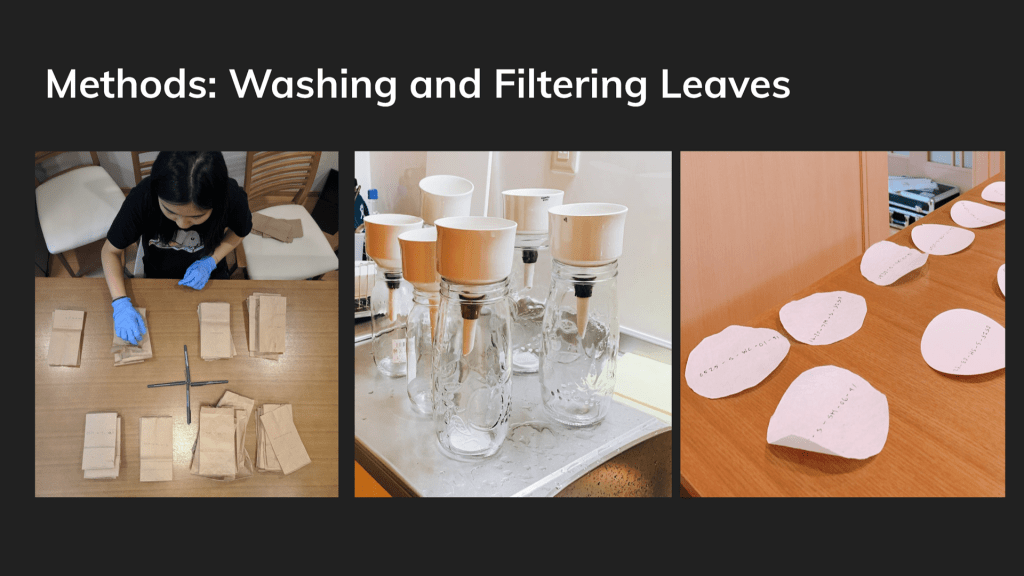Seventeen students from the Claremont Colleges participated in the May 2019 Clinic Trip to Japan. Students worked on specific research projects in teams led by a professor in the field. Nhi Phan (environmental analysis, CMC ’21) was part of Professor Marty Meyer’s (biology, POM) Trees Lab along with Willow Coleman (math, HMC’ 21), Kyra Madunich (biology, POM ‘21), and Julie Xu (environmental analysis, Pitzer ‘22). Here Nhi (wearing pink in photo above) shares two reflections from two days of activities in Japan.
Teamwork within Field Work
May 24, 2019
By Nhi Phan (environmental analysis, CMC ’21)
Today was our first official day doing work specifically for our lab research on how trees serve as bio-filters that clean the air of particulate matter (PM). It was my first time doing field work, and especially interesting to experience the process of starting a project on-site. There were many logistics and plans to work out in order to conduct the experiment, which included collecting leaf samples from a Kyoto park and analyzing their PM. The process of figuring out how to do the experiment was very valuable for me. We went through some hardships while trying to standardize the samples, so I learned a lot from our trials and errors. For example, tree species differed in availability with some only having three per roadside compared to others that would have dozens. Thus, we had to devise ways to account for the variance and other variables in to order to ensure consistency. In our data analysis, we made sure to include the amount of samples collected as a factor in the results since they varied from species to species. This was because we decided that having a variety of species to analyze was more important, so we comprised to keep them in the data.
Today’s sampling and later sample processing made me realize truly how important cooperation is. I tend to be more of an independent worker and prefer to work alone. However, I learned the value of teamwork through my time working on this experiment. If not for my group mates, I doubt I would have been able to complete the experiment on my own without taking up weeks and excessive amounts of brainpower. We bounced ideas and plans off each other, making our methods and thinking much clearer. The sample processing was also tedious and time consuming, and if not for Julie and Willow who took the initiative to buy extra jars to hold the filters, I doubt we would have finished before midnight.
The process can be summarized as such: first, we had to pre-weigh all of the filters we were using, classified into two types depending on the size of PM they collected. Second, we had to wash all of the leaf samples in beakers to collect its PM, taking care to not lose any PM in the process. Third, we had to pour the water through the filters and wait for it to drip through and deposit the PM onto the filters. Then, these filters would be weighed after a night of drying in order to determine the weight of PM collected. Since each water sample had to first go through the larger filter before being transferred to the smaller one, we had to wait for each large filter to finish and keep track of which filter water had been poured through what. Additionally, the smaller filters were excruciatingly slow and would take anywhere from 10 to 30 minutes to finish draining. This, coupled with hundreds of samples and a limited time frame caused a lot of stress for all of us. Thanks to Julie and Willow again for getting more jars so we could filter more – they really saved us time.
All in all, today was quite a valuable day for me. Not only did I experience field work, which I see as integral to my future career, I also learned more about how to work effectively with my lab mates to yield the best results.
At the Hiroshima Peace Memorial Museum
May 27, 2019
Amidst our busy schedule of collecting and processing data, our group still managed to squeeze in a day trip to Hiroshima. We visited the Hiroshima Peace Memorial Museum, and it was one of the most moving experiences from the entire trip. It is difficult to fully describe the somber and sorrowful tension of that museum while walking through the darkened halls, spotlights on tattered memorabilia, the quiet sniffles resounding throughout the otherwise silent halls. I hadn’t realized how stuffy my heart and throat felt until I stepped out of the exit and faced the view of the Peace Memorial itself. Actually seeing pictures and belongings of the people affected by the bombings placed the disaster in a new context for me; it felt so much more personal.
Oftentimes, when we read or learn about disasters that severely destroy the livelihood of others, our sympathy is only surface-level as we have not experienced it ourselves. Personally, before this trip and class, I had lacked much knowledge of the Fukushima disaster and Hiroshima and Nagasaki bombings outside of general information. I had not really tried to understand the disasters on a deeper level – perhaps out of fear – until I was confronted with them on this trip. While experiencing these tragedies on a deeper level was indeed scary and saddening, I am glad I got to learn more about them and go through that pain. My understanding and perspective have greatly been broadened, even if my connection necessarily wasn’t.


